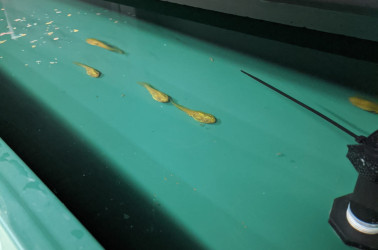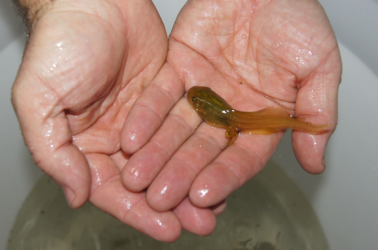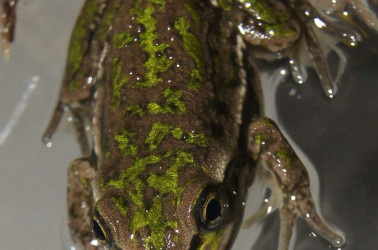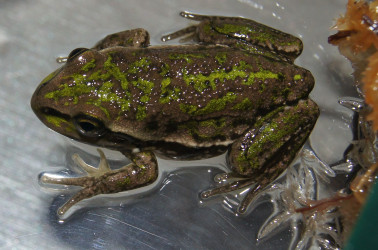The Project:
The Southern Bell Frog is in decline across much of its range and in some regions, it has disappeared altogether. In the lower Murray River in South Australia the species has declined from fifty known populations to just one. This project will focus on conserving and expanding populations through establishing a captive breeding and release a program.
This important project could be the last chance for Southern Bell Frog populations in South Australia.
Urgency and action:
Amphibians are the world’s most threatened vertebrate taxa and in the Murray‐Darling Basin, one third of the 55 species of frogs are now threatened.
The Southern Bell Frog was formerly common throughout much of south-eastern Australia, but has suffered a substantial decline in range and abundance in recent decades. It has disappeared from the ACT and much of its former range in NSW. With just one population remaining in South Australia proactive interventions are urgently required to conserve the Southern Bell Frog before it disappears altogether.
Threats:
Threats to the the Southern Bell Frog include the loss and degradation of habitat, droughts, disease, predation by red fox, cats and introduced fish species, herbicides used in agriculture.
Solution:
With your support we’ll significantly increase the population of Southern Bell Frogs in the wild, through establishing a conservation facility designed and purpose built to conserve Southern Bell Frog that will enable captive breeding and ongoing release to the wild.
To achieve this, we will;
construct and fit out of the captive breeding facility at Clayton Bay, South Australia, as well as develop operating and breeding protocols, and
collect Southern Bell Frog broodstock and promote spawning and juvenile development to complete the lifecycle.
The development of translocation protocols will support their release into surrogate refuges and wild sites. The facility operating and translocation protocols will then be documented to support potential replication of the program for the Southern Bell Frog in other states and for other endangered frog species.
This program will then be complemented by information session to educate and engage community members.
The Project will also;
establish maintenance and breeding of the species using best‐practice protocols determined in consultation with experts (e.g. Melbourne Zoo),
facilitate routine housing, breeding and grow out in a manner that reduces risk (e.g. disease) to captive and wild populations,
installation of solar power to reduce ongoing operational costs,
incorporate stakeholder and community engagement to achieve broad support, securing the long‐term sustainability of the facility, and
importantly, the project aligns with the national recovery plan for the species.
Best practice will be undertaken throughout the project.
Collection, quarantine and establishment of Southern Bell Frog broodstock. Broodstock will be supplemented with new wild‐caught individuals on a regular basis to increase genetic diversity within the captive population and reduce the risk of genetic bottlenecking at release sites.
Rigorous research, site visits and a workshop will be undertaken to develop robust operating and breeding protocols. These will promote successful spawning and juvenile development with low mortality rates
Potential release sites will be identified in collaboration with the South Australian Department of Environment and Water which meet the established habitat requirements for Southern Bell Frog.
Strategic site selection is central to the successful reintroduction and persistence of captively bred frogs.
Host an information evening to provide information about the species, the project and involvement opportunities. Consistent community engagement is key to the ongoing success of the project
Frog breeding, release and monitoring will be complimented using a citizen science approach with community members, local residents and school groups. The engagement of these groups will support the successful conservation of this species.
2021 onwards:
Ex situ breeding takes place at the new facility in Clayton Bay, South Australia. This takes place in two areas: outdoor breeding facilities and an indoor hatchery.
Once a viable captive breeding program is successful the aim is to re-establish a self-sustaining meta-population of Southern Bell Frogs in the Murray River of South Australia downstream of Morgan.
Project Partners:
The Trustee for Nature Glenelg Trust, operating as Aquasave‐Nature Glenelg Trust will implement this project.
The Clayton Bay Nursery and Environment Group will host the facility on land owned by Alexandrina Council.
Peter and Mia Mirtschin
Expert advice and input is being provided by Melbourne Zoo Amphibian Breeding Facility, Adelaide University and members of the SA Murray Darling Basin NRM Board.
The South Australian Department of Environment and Water are assisting with permits.
ADDITIONAL FUNDING PROVIDED:
Professor Michael J Tyler AO was an icon in Australian conservation. He described new species of frog, advanced global herpetology and was Chairman of the South Australian Museum. His passing in March 2020 marks a deep loss for Australia.
In late 2020, Mike’s family uncovered two bound journals of field notes. The journals span fieldwork from 1976 to 1994 and include observations from every state and territory in Australia. These observations do not appear in any Australian database and include new location records and populations which are now locally extinct. FAME are proud to work in partnership with Rupert Mathwin Ecology to support the transcription of these journals onto the national record and we are certain they will play a pivotal role in future conservation planning.
UPDATES:



